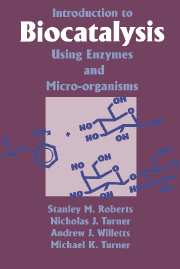Book contents
- Frontmatter
- Contents
- Preface
- Abbreviations
- 1 An historical introduction to biocatalysis using enzymes and micro-organisms
- 2 The interrelationships between enzymes and cells, with particular reference to whole-cell biotransformations using bacteria and fungi
- 3 Useful intermediates and end-products obtained from whole-cell/enzyme-catalysed hydrolysis and esterification reactions
- 4 Useful intermediates and end-products obtained from biocatalysed oxidation and reduction reactions
- 5 Useful intermediates and end-products obtained from biocatalysed carbon–carbon, carbon–oxygen, carbonnitrogen and carbon–chalcogen bond-forming reactions
- 6 The application of biocatalysis to the manufacture of fine chemicals
- Index
1 - An historical introduction to biocatalysis using enzymes and micro-organisms
Published online by Cambridge University Press: 04 August 2010
- Frontmatter
- Contents
- Preface
- Abbreviations
- 1 An historical introduction to biocatalysis using enzymes and micro-organisms
- 2 The interrelationships between enzymes and cells, with particular reference to whole-cell biotransformations using bacteria and fungi
- 3 Useful intermediates and end-products obtained from whole-cell/enzyme-catalysed hydrolysis and esterification reactions
- 4 Useful intermediates and end-products obtained from biocatalysed oxidation and reduction reactions
- 5 Useful intermediates and end-products obtained from biocatalysed carbon–carbon, carbon–oxygen, carbonnitrogen and carbon–chalcogen bond-forming reactions
- 6 The application of biocatalysis to the manufacture of fine chemicals
- Index
Summary
Background
Each year that passes sees increasing interest in the application of enzymes and micro-organisms as catalysts in organic chemistry. Well-received national reports on the potential growth of biotechnology, not to speak of numerous reviews of the topic of biotransformation itself, have described the advantages which biological catalysis can bring to complex organic syntheses. At this time it is indeed an exciting prospect for anyone who has a role to play in the development of this new technology. But occasionally a prospective participant, as well as a reviewer, ought to stand back and ask, Why has this explosion of interest happened now?
An answer to such a question often lies in the historical context from which technologies and their underlying science develop. This is a topic worthy of greater attention than it usually receives from practising scientists. A resort to scientific papers more than one or two decades old is frequently viewed as perverse, while to consult the scientific literature of the past century in search of a pertinent contemporary lesson is simply eccentric. Yet this old literature can be worth reading for the light it can shed on current research, quite apart from which, it is, more often than not, a pleasure to read.
The biochemistry of the late nineteenth century has an interesting connection with the manufacture of vitamin C. The basis of this process relied on the development of the concepts of fermentation and catalysis, but it emerged directly from a microbial oxidation described in a short paper written by Adrian Brown (1886a).
- Type
- Chapter
- Information
- Publisher: Cambridge University PressPrint publication year: 1995
- 1
- Cited by



